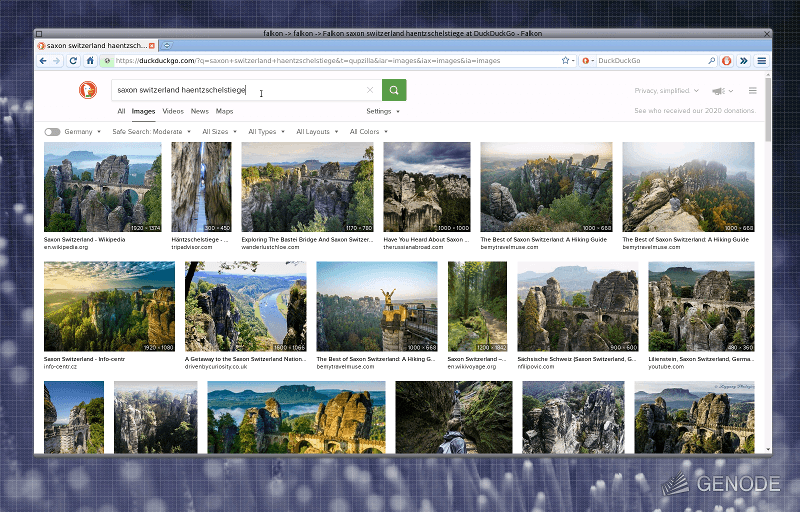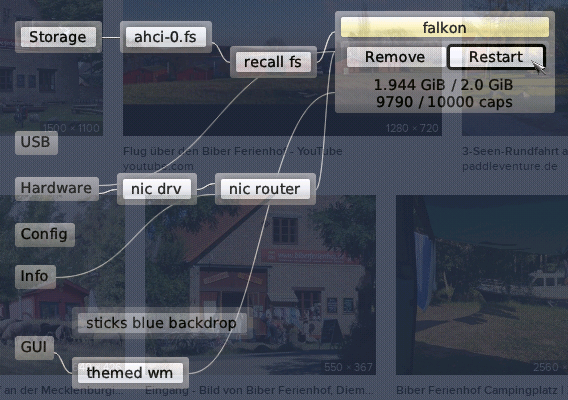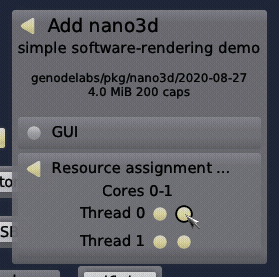What's new in Sculpt OS 20.08
The version 20.08 of Sculpt OS has just become available. Let's have a look at the most interesting changes and new features.
Before we start, download the new Sculpt OS image while it's hot:
- Sculpt download page
- Up-to-date documentation
Falkon web browser
Functionality-wise, the most interesting addition is a ready-to-install package for the Falkon web browser. You can find the browser in the depot of cproc:
-
Add the window manager as described by the Sculpt documentation or - if you prefer the luxury variant - by following this article.
-
Obtain the depot index of "cproc" via the "+" menu.
Depot... -> Selection... -> cproc
-
Add the Falkon web browser via the "+" menu.
Depot... -> cproc... -> Tools... -> falkon
Connect it as follows:
-
File system (downloads) -> ram fs
This is the location where the browser will put files downloaded from the internet. Apart from this location, the browser won't be allowed to store any information (cookies, caches) persistently on your system. This is a feature because we cannot help but distrust a monstrosity like Chromium. By selecting the RAM file system as download location, the downloaded files will also vanish upon reboot.
-
GUI -> themed wm
This is the GUI server used for presenting the browser windows.
-
Network -> nic router
It goes without saying that the browser requires network access. So we connect it to Sculpt's virtual NAT routing component.
-
Report (falkon shape) -> themed wm
This allows the browser to change the mouse-pointer shape according the hovered context.
-
Report (clipboard) -> themed wm
By directing clipboard reports to the window manager, we can copy text from the browser to the global clipboard. You can find more information about the clipboard mechanism in this dedicated article.
-
ROM (clipboard) -> global clipboard
Vice versa, this allows the browser to read content from the global clipboard.
-
Real-time clock -> system time
-
The browser is based on the Chromium web engine. Thereby, it supports the "modern" web as expected by most users. Its user interface loosely resembles Firefox. E.g., it features the usual hamburger menu on the right, and supports the most common keyboard shortcuts.

|
Granted, this initial version of the browser is not yet fit for everyday use. It will take us continues effort to improve the performance to the level expected by most users, to reduce its memory demand, and to prevent memory leaks. We will get there. For now, please regard the browser as work in progress. Should you find it frozen, have a look at Sculpt's log display. The most likely cause of problems is the depletion of the memory quota.

|
In this situation, a new feature of Sculpt comes to the rescue:
Restarting components via mouse click
When selecting a component in Sculpt's component graph, you will find a new "Restart" button in addition to the traditional "Remove" button. This button resets the component to its original state.

|
Assigning components to CPUs
The previous version of Sculpt already featured a manual way of restricting components to a subset of CPUs. This becomes handy in situations where one wants to run two virtual machines largely decoupled from each other, or when hosting latency-critical workloads - like audio - alongside heavy programs. With the new version of Sculpt, the CPU assignment of each component can be interactively configured.

|
The configuration dialog shows a matrix of CPU cores where the x-axis denotes the physical cores and the y-axis the hyperthreads. By default, all available CPU cores are selected. You can toggle the nodes by clicking on them. The dialog ensures that the selection is always a rectangular area. So one click may affect nodes other than only the clicked one. This Tic-Tac-Toe-like behavior may feel a bit eccentric at first, but it is super convenient.
Changing VESA screen resolutions on the fly
When running Sculpt in a virtual machine like VirtualBox, Sculpt relies on the VESA framebuffer driver. In previous versions, the screen resolution was fixed to 1024 x 768. The new version overcomes this limitation. You can change the resolution to another VESA mode - i.e., 1280 x 768 - by editing the width and height attributes of the fb_drv configuration on the config file system.
The event filter has replaced the input filter
As a consequence of Genode's redesigned GUI stack, the former input-filter component has been replaced by the new event filter component. It is now configured via /config/event_filter file.
The configuration of the filter chain remains almost the same. Only the declaration of the top-level <input> nodes is no longer needed. Instead, the configuration must specify <policy> nodes, which define the mapping of "Event" clients (event sources) to the inputs used in the filter chain.
The noux runtime is no more
Earlier versions of Sculpt relied on the so-called noux runtime for executing Unix-like subsystems. The new version does no longer require noux because Genode's regular C runtime covers the needs of Unix-like subsystems now. The former "noux-system" package has been replaced by a new "system shell" package. Its purpose and feature set is unchanged.
Further improvements
There are the following noteworthy improvements under the hood:
-
The entire GUI stack from the drivers, over the low-level GUI server, the window manager, up to the applications and virtual machine monitors uses 32 bits per pixel now. This change generally results in crisper graphics. By eliminating intermediate color-space conversions and dithering, there are also welcome performance improvements all over the place.
-
The redesigned GUI stack has has reduced the latency of user input, which makes the user interface more snappy and direct.
-
Changes of the font size in the top-left "Settings" menu take immediate effect without the need for restarting GUI components.
-
Unsupported partition schemes are now gracefully handled. Sculpt utilizes Genode's heartbeat-monitoring mechanism to detect the failure of part_block instances during storage discovery. If part_block gets stuck, the device is released and can thereby be accessed at the whole-device level, e.g., by assigning it to a virtual machine.
I wish you a lot of fun with the new version of Sculpt OS!


 Norman Feske
Norman Feske